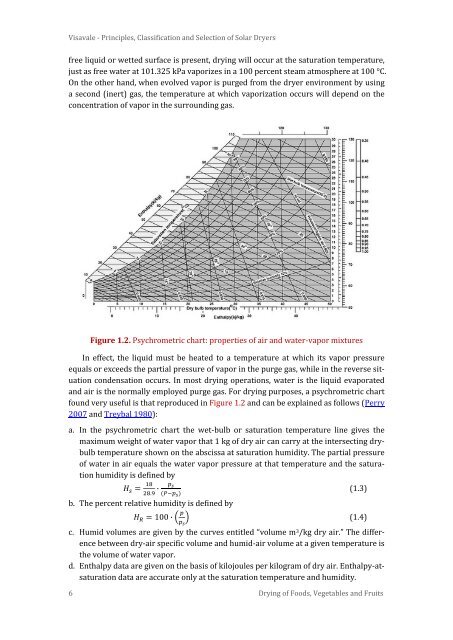Solar Drying: Fundamentals,Applications and Innovations - National ...
Solar Drying: Fundamentals,Applications and Innovations - National ...
Solar Drying: Fundamentals,Applications and Innovations - National ...
You also want an ePaper? Increase the reach of your titles
YUMPU automatically turns print PDFs into web optimized ePapers that Google loves.
Visavale - Principles, Classification <strong>and</strong> Selection of <strong>Solar</strong> Dryers<br />
free liquid or wetted surface is present, drying will occur at the saturation temperature,<br />
just as free water at 101.325 kPa vaporizes in a 100 percent steam atmosphere at 100 °C.<br />
On the other h<strong>and</strong>, when evolved vapor is purged from the dryer environment by using<br />
a second (inert) gas, the temperature at which vaporization occurs will depend on the<br />
concentration of vapor in the surrounding gas.<br />
Figure 1.2. Psychrometric chart: properties of air <strong>and</strong> water-vapor mixtures<br />
In effect, the liquid must be heated to a temperature at which its vapor pressure<br />
equals or exceeds the partial pressure of vapor in the purge gas, while in the reverse situation<br />
condensation occurs. In most drying operations, water is the liquid evaporated<br />
<strong>and</strong> air is the normally employed purge gas. For drying purposes, a psychrometric chart<br />
found very useful is that reproduced in Figure 1.2 <strong>and</strong> can be explained as follows (Perry<br />
2007 <strong>and</strong> Treybal 1980):<br />
a. In the psychrometric chart the wet-bulb or saturation temperature line gives the<br />
maximum weight of water vapor that 1 kg of dry air can carry at the intersecting drybulb<br />
temperature shown on the abscissa at saturation humidity. The partial pressure<br />
of water in air equals the water vapor pressure at that temperature <strong>and</strong> the saturation<br />
humidity is defined by<br />
H s = 18<br />
∙ p s<br />
(1.3)<br />
28.9 (P−p s )<br />
b. The percent relative humidity is defined by<br />
H R = 100 ∙ p (1.4)<br />
p s<br />
c. Humid volumes are given by the curves entitled “volume m 3 /kg dry air.” The difference<br />
between dry-air specific volume <strong>and</strong> humid-air volume at a given temperature is<br />
the volume of water vapor.<br />
d. Enthalpy data are given on the basis of kilojoules per kilogram of dry air. Enthalpy-atsaturation<br />
data are accurate only at the saturation temperature <strong>and</strong> humidity.<br />
6 <strong>Drying</strong> of Foods, Vegetables <strong>and</strong> Fruits

















